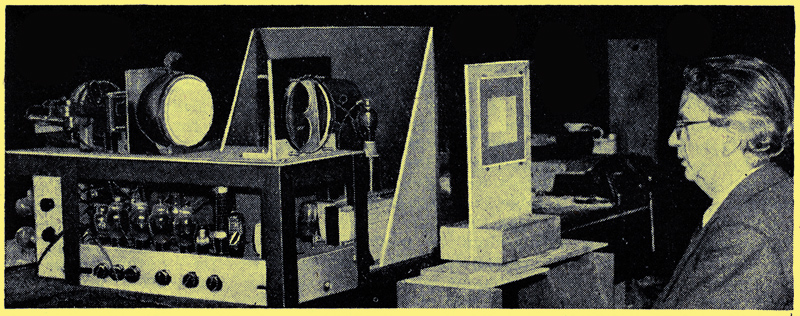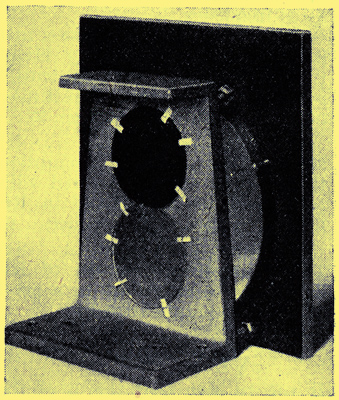|
Receiver Without Moving Parts

An experimental model of the new receiver, with Mr Baird seated in front of the viewing screen.
Stereoscopic television employing the anaglyphic* principle and colour television viewed on an receiver which employed no moving parts was recently demonstrated by John Logie Baird at his private laboratory at Sydenham.
The former achievement was demonstrated early last year and described in the February, 1942, issue of this journal. It is therefore not considered necessary that the system should be fully described here, but it may be pointed out that the anaglyphic principle is based on the use, by the viewer, of spectacles fitted with colour filters in place of lenses, for the purpose of left- and right-eye discrimination, the stereo-scopic pair being produced at the receiver screen in corresponding colours to the red and blue filters. Each component of the stereoscopic pair will then be seen only by the eye covered by its particular filter, so that each component will be viewed in turn. As the pictures on the screen are slightly displaced, according to the left- and right-eye viewpoints at the transmitter, and superimposed, a resultant picture in stereoscopic relief is obtained.
In the February, 194I, issue of Wireless World there was described a 600-line colour television system employing a two-colour process of red and blue-green making use of a rotating disc carrying the colour filters.
Stationary Filters

Optical system of the new Baird colour television receiver
Baird has realised for some time that the use of moving parts in a receiver constitutes a very real drawback, particularly to the non-technical user, and therefore decided to develop a receiver employing stationary colour filters. The apparatus, shown diagrammatically in the accompanying drawing, employs the principle ol superimposing, by optical means, coloured images representing the primary colours. For the sake of simplicity, Baird uses the same colour combination as was employed in the above-mentioned partially mechanical system; that is, a two-colour combination of orange-red and blue-green.
Images corresponding to the primary colours employed are reproduced side by side in sequence on the cathode-ray tube. Two lenses, one covered with an orange-red and the other with a blue-green filter, are arranged with their optical centres on perpendiculars through the centres of each of the images, and at a distance from them equal to the focal length of the lenses. It is arranged that the lenses project parallel beams on to a large lens situated at a distance from the receiving screen equal to its focal length. The resultant coloured picture is obtained from this super-imposition of the two coloured pictures. One of the accompanying photographs indicates the general layout of the optical system, the other shows the lens system, with the colour filters in front of the lenses.

The arrangement of lens and colour filter system.
* Anaglyphic: having the appearance of an ornamental carving or embossing done in low relief.
|